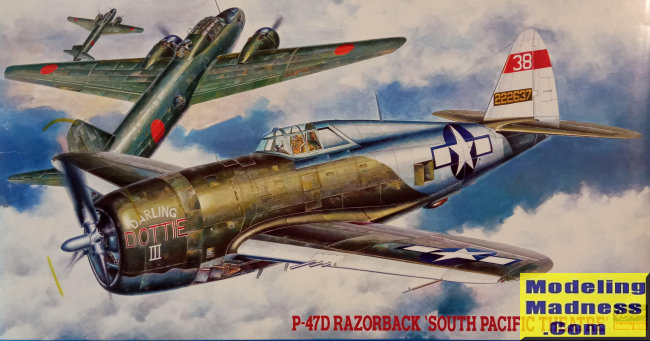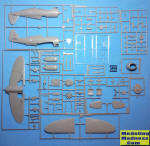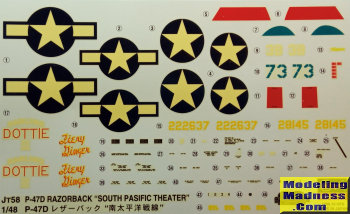
| KIT #: | 09058 (Jt 58) |
| PRICE: | $30.00 |
| DECALS: | Two options |
| REVIEWER: | Spiros Pendedekas |
| NOTES: | 1999 Edition |

| HISTORY |
One of the heaviest
single engine fighters of WWII, the Republic P-47 Thunderbolt was produced by
Republic Aviation from 1941 through 1945. Designed around the powerful Pratt &
Whitney R-2800 Double Wasp 18-cylinder radial engine, it featured an advanced
turbo-supercharger system that ensured the aircraft's eventual dominance at high
altitude. Its primary armament was eight .50-caliber machine guns, and in the
fighter-bomber ground-attack role it could carry 5-inch rockets or a bomb load
of 2,500 lb (1,100 kg). Its armored cockpit was relatively roomy and
comfortable.
The P-47 was one of the main USAAF fighters of World War II, excelling in both
European and Pacific theaters, not only as a short-to medium-range escort
fighter in high-altitude air-to-air combat, but also in ground attack. It
additionally served with other Allied air forces, including those of France, the
United Kingdom, and the Soviet Union. Mexican and Brazilian squadrons fighting
alongside the USAAF also flew the P-47. A total of 15,636 units of this
successful plane were built.
| THE KIT |
 Hasegawa
came in 1996 with its fine bubble canopy quarter scale P-47 series, followed by
the “Razorback” version in 1998. Since then those kits have been reboxed more
than 20 times in total, offering many interesting decal schemes, some of the
reboxings being of the “limited Edition” type, per the standard (and very nice)
Hasegawa style. My copy was the 1998 Razorback "South Pacific Theatre" Edition,
bought from my usual Athens hobby shop back then.
Hasegawa
came in 1996 with its fine bubble canopy quarter scale P-47 series, followed by
the “Razorback” version in 1998. Since then those kits have been reboxed more
than 20 times in total, offering many interesting decal schemes, some of the
reboxings being of the “limited Edition” type, per the standard (and very nice)
Hasegawa style. My copy was the 1998 Razorback "South Pacific Theatre" Edition,
bought from my usual Athens hobby shop back then.
The kit comes in a top opening medium sized box of excellent quality, with a
Koike Shigeo (as always superb) box art, featuring P-47D-3-RA "Darling Dottie
III" of 348th Fighter Group attacking a Mitsubishi Betty formation. Upon opening
the box, I was greeted with 85 dark gray styrene parts, arranged in 12 sprues of
various sizes. The sprues arrangement obviously reflects Hasegawa’s approach to
use as many common sprues as possible at both the Bubble Top and Razorback
editions, with the "differentiating" parts arranged in their own sprues.
Molding of the typical somehow hard Hasegawa plastic is crisp with panel lines finely recessed and no flash whatsoever. I did not find any ejector pin marks at any visible area. All sprues are sealed together in a single bag (again, per the usual Hasegawa style), meaning some potential scratches. At least the clear sprue is separately sealed, together with the decal sheet
General shape of
parts looks correct, with the exception of the aircraft's 'keel' that is not
deep enough (Hasegawa did not account for additional depth added for the
plumbing needed, in order for the type’s modification to carry a drop tank).
Cockpit is well appointed, featuring instrument panel with molded on dials, gun
sight, seat with separate rear frame, stick, rudder pedals, rear bulkhead with
separate cushion, sidewalls with molded on details and separate throttle
quadrant. A nice decal is to be affixed onto the instrument panel and succumb
onto each dial, should you wish so (which is not a bad idea, as Hasegawa
instrument decals are typically accurate and succumb well onto the molded
dials). Apart from adding some seat belts, the cockpit will look sufficient out
of the box for most of us.
Landing gear is also very well executed, the wheels feature the correct rims for
the version and the bays are fully boxed featuring adequate internal detail. I
would not bother if hasegawa provided brake lines, either molded onto those nice
gear legs or separate. The engine, another most prominent feature of the P-47,
is equally nicely represented with good dept and believable representation of
the left/right oil filter meshes, the only thing missing being ignition
harnesses.
The drop tank with its sway braces and plumbing looks very nice and the same can
be said for the propeller which seems to be the correct one for the version. The
blades are separately given, possibly due to Hasegawa’s approach to retain the
commonly used hub and provide different blades, in order to cater for the
different prop types. Though in general building a prop increases build
complexity and demands good alignment, in the case of Hasegawa, prop assembly is
most of the times a breeze. The very effective poly caps are also present for
securing the assembled prop to the engine.
Clear parts are excellently molded and crystal clear. Instructions come at the
usual nice and totally comprehensive Hasegawa pamphlet, containing a short
history of the type, a parts list, with the construction spread in 9 very clear
steps. Color callouts are given throughout in Gunze and Mr Color codes.
 Two very
attractive 348th Fighter Group Pacific schemes are provided, #22637 “DARLING
DOTTIE III” and Col. Neel E. Kearby’s (Squadron C/O) #28145 “Fiery Ginger”. Both
are basically olive drab over neutral gray with white fins, with "Darling Dottie
III" also featuring a silver rear fuselage. The decals have the white
represented as “ivory”, which might bother a number of modelers, but are
otherwise superbly printed, not looking too thick, with time seeming not to have
affected them in any way.
Two very
attractive 348th Fighter Group Pacific schemes are provided, #22637 “DARLING
DOTTIE III” and Col. Neel E. Kearby’s (Squadron C/O) #28145 “Fiery Ginger”. Both
are basically olive drab over neutral gray with white fins, with "Darling Dottie
III" also featuring a silver rear fuselage. The decals have the white
represented as “ivory”, which might bother a number of modelers, but are
otherwise superbly printed, not looking too thick, with time seeming not to have
affected them in any way.
Instructions want you to first assemble the cockpit and trap it between the
fuselage halves, followed by attaching the horizontal stabilizers. The main bays
are next assembled and trapped between the wing halves, with the assembled wing
attached underneath the fuselage immediately after.
The landing gear and drop tank are next assembled and attached, with the engine,
cowling, prop and transparencies to follow, ending a very straight forward and
seemingly uncomplicated build.
| CONCLUSIONS |
Apart from the “keel” depth (something that might not bother too much a
number of us, Yours Truly included), this venerable kit looks to be a very good
representation of the iconic Thunderbolt. Overall shape (keel depth excluded)
looks correct, detail is really nice in general and especially at the key areas
of cockpit, landing gear and engine, molding is superb, transparencies are great
and the schemes are really interesting. Decals exhibit the “ivorizing” white
Hasegawa phenomenon, but are otherwise very good.
Posing no real challenges during construction and generally building well, as
you can see at the MM archives reviews, this is a kit worth building.
Happy modeling!
August 2022
Copyright ModelingMadness.com. All rights reserved. No reproduction in part or in whole without express permission.
If you would like your product reviewed fairly and quickly, please contact the editor or see other details in the Note to Contributors.